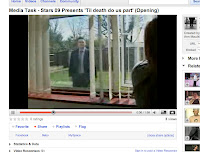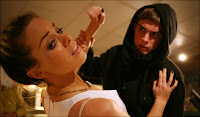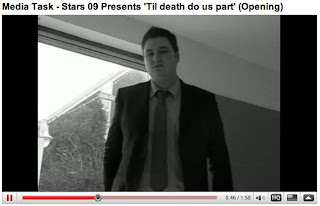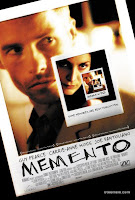1. In what ways does your media product use, develop or challenge forms and conventions of real media products?
We named our film ‘Til Death Do Us Part’. We chose this title as we thought it was a hint of the plot, and it creates a mysterious yet threatening atmosphere which is what we had planned. A member of our group (Jermaine) designed and made the music for our media. We were very happy with this because this music added to the suspense and mystery that the title suggests. The slow, gloomy sounding piano creates this mystery. We were trying to create the effect of a flashback as this showed a change of thought and time. We also used black and white in the flashbacks to differentiate between the past and the present. When watching Memento, which also used this effect, we noticed that they subverted the conventional use of black and white, which had an effect on the way the audience viewed the film. When preparing to begin this project we watched ‘The Birds’ – Alfred Hitchcock. In this thriller he took an every-day, ordinary setting and subverted this by the strange, extra-ordinary events that then started happening. This idea influenced us greatly when we thought about the mise-en-scene, as the image of an ordinary domestic setting was destroyed as soon as the male character was introduced, as we introduced him to be untrustworthy and creepy; see screen-shot below for an example (Even though later on in the narrative he turns out to be the victim. This is not evident in the opening!). We established this by the mise-en-scene; nothing in the background seemed abnormal in any way, they were just every day objects creating an ordinary home.

We kept the lighting in all scenes to the natural light when filming to emphasise that wanted sense of normality in our protagonist’s life. We were aiming to subvert the conventional dangerous man vs. innocent/victimised woman in the narrative (for example; image below), though this wasn’t made entirely evident in the opening as it would have defeated the point of the non-linear narrative.

We used a non-linear narrative as we wanted our story-line to be unsettling and to create a sense of being bewildered for the audience. This use of a non-linear narrative is typical to the psychological thriller genre, as it confuses the audience emphasising the psychological impact the narrative has. Memento was very influential when we were thinking about how to structure our film, as when watching Memento the audience feels completely helpless to what is going on in the narrative. The Usual Suspects was helpful in helping us create false impressions of characters, as when we get to the end of the film, we find out the victim is in fact the villain.
2. How does your media product represent particular social groups?
In Western culture, women are often viewed as emotional and irrational as opposed to men who are seen as reasonable, hence their right to operate in the public world, where women are confined to the private, domestic sphere. It could then be argued that we have adopted this Western view, by having our villain a woman. We chose to adopt this view as we wanted to challenge the often used stereotypical male villain, female victim. Our target audience would want to watch something that's a little different to a lot of thrillers in the box office, so would therefore be more attracted to our movie as there's a female villain. During the opening, the characters are seen very differently to how they would have been later on in the film.
2. How does your media product represent particular social groups?
In Western culture, women are often viewed as emotional and irrational as opposed to men who are seen as reasonable, hence their right to operate in the public world, where women are confined to the private, domestic sphere. It could then be argued that we have adopted this Western view, by having our villain a woman. We chose to adopt this view as we wanted to challenge the often used stereotypical male villain, female victim. Our target audience would want to watch something that's a little different to a lot of thrillers in the box office, so would therefore be more attracted to our movie as there's a female villain. During the opening, the characters are seen very differently to how they would have been later on in the film.

As the female in our opening doesn’t seem mysterious or guilty of any offence (see photo above, she seems quite the opposite) there is more of a bad reputation placed on men, as he’s the one that seems dodgy in the opening. We created this dodgy atmosphere by never completely introducing him in the opening. This point can be proven by our audience feedback - I uploaded our opening to the social networking website Facebook, where I asked friends and family to comment on how effective they thought the opening would be, and how they thought the narrative would be later on in the film. One comment read; "It's a good opening as it doesn't tell too much about the story. I'm guessing the man is the villain - possible relationship turned bad?" The audience sees him walking behind closing blinds - this automatically seems like a strange thing to do so he's placed in the role as the villain. Stereotypically, criminals are considered to be people from lower social backgrounds. We aimed to subvert this notion in our opening by showing the Smith’s to be middle-class, yet still committing crimes (though it is not evident any crimes have been committed this early in the story line). We aimed to show this through our use of costume (male wearing smart suit and tie throughout-see photo below, female wearing simple everyday yet smart looking clothes), and our use of set (well kept, large garden, tidy and spacious study).
 3. What kind of media institution might distribute your media product and why?
3. What kind of media institution might distribute your media product and why?After research, I came to the conclusion that Pathé Distribution would be likely to distribute our film. I originally decided an independent, English company would most likely distribute ‘Til Death Do Us Part’, yet Pathé caught my eye as they have recently distributed one of our main influential films – ‘Memento’, giving me the impression that they may be interested in the type of film that we have started. They have also distributed films like ‘Slumdog Millionaire’ – a film that has had great success through Pathé.
 They distribute for about 20 titles per year, "ranging from quality and specialised films to crowd-pleasing mainstream movies and genre titles" (Pathé website). This would give our film a wide audience which would give the film a larger chance to be introduced to our target audience.
They distribute for about 20 titles per year, "ranging from quality and specialised films to crowd-pleasing mainstream movies and genre titles" (Pathé website). This would give our film a wide audience which would give the film a larger chance to be introduced to our target audience.4. Who would be the audience for your media product?
During the first stages of the project, we decided to design surveys to ask different people to fill in. Personally, most of the people that answered my survey were from years 11, 12 and 13 so we could get our target audience's opinion, yet there are still some surveys filled out by people older than this to see their views also. After carefully looking at our audience research and feedback, we chose to target our film at 15-25 year olds. We didn’t think the film would be appropriate for those younger than fifteen as some parts of the narrative may be disturbing/upsetting for them, and we'd therefore have to change our original story line. ‘Til Death Do Us Part’ is being targeted at both males and females, as psychological thrillers may apply to both. From the survey below, we gathered to make a good opening (opinions of those that took survey) - our opening had to have a complicated, yet interesting story line (question 2 of survey below), yet an opening that doesn't reveal too much about the story line - this needs to be saved for later on in film!
5. How did you attract/address your audience?
Our audience feedback told us that we needed to create a sense of mystery to draw in the audience as soon as the opening started. We created this sense of mystery immediately by showing the female looking at a photograph, yet half of the photograph is hidden. Later on in the film, the audience would see the rest of this photo but to entice the audience; it’s hidden in the opening, forcing them to carry on watching to see who photo is of.
Our audience feedback told us that we needed to create a sense of mystery to draw in the audience as soon as the opening started. We created this sense of mystery immediately by showing the female looking at a photograph, yet half of the photograph is hidden. Later on in the film, the audience would see the rest of this photo but to entice the audience; it’s hidden in the opening, forcing them to carry on watching to see who photo is of.

We also used music to entice the audience and make them carry on watching. The music reflects her misery at first, when it’s slow and gloomy sounding. When the tension picks up, the music quickens subconsciously increasing the audience’s interest in the film.
Our use of editing; particularly our use of black-and-white emphasises the mystery in our opening. This use of black-and-white was to show the difference between the normal events and the flashbacks the character is experiencing. This use of editing addresses the audience and makes them want to watch more of the film as they will be more inclined to want to know why the characters having flashbacks and what these flashbacks are actually of (we cut the flashback into two separate sections, disorientating the audience).
Our use of editing; particularly our use of black-and-white emphasises the mystery in our opening. This use of black-and-white was to show the difference between the normal events and the flashbacks the character is experiencing. This use of editing addresses the audience and makes them want to watch more of the film as they will be more inclined to want to know why the characters having flashbacks and what these flashbacks are actually of (we cut the flashback into two separate sections, disorientating the audience).
6. What have you learnt about technologies from the process of constructing this product?
When we were first introduced to the project most of my group hadn’t used a Macintosh before, so were struggling with the differences that Macs and PCs have. I was lucky that I have had experience on Macs before, so the change in computers didn’t faze me at all. This project has made me feel a lot more at ease with technology like iMovie for example, though. Previous to A-Level media, I had never used iMovie, I had only used programs such as Windows Movie Maker. As I had only used the Windows movie program and hadn’t used the Mac version, I was slightly sceptical about learning how to use the whole new program. I was introduced to it and shown how to cut and edit things, how to use the timeline and clips pane, and slowly I started to get used to iMovie. Once I’d got used to the sudden chance in software, I decided iMovie was much easier to work with and much more effective than Windows Movie Maker, which I find always crashes! I would have liked iMovie a lot more if it enabled us to layer video, alongside audio. It was helpful that they allow the overlapping of audio, yet we chose not to use this in our film. We did want to overlap video though, where Michael Graham walks past the window whilst the blinds are being shut. We originally wanted Michael to disappear, showing clearly that he’s a ghost, but after trying to create this effect for a while, we decided it didn’t give us the effect we wanted, and it may give too much away in the narrative.
When we were first introduced to the project most of my group hadn’t used a Macintosh before, so were struggling with the differences that Macs and PCs have. I was lucky that I have had experience on Macs before, so the change in computers didn’t faze me at all. This project has made me feel a lot more at ease with technology like iMovie for example, though. Previous to A-Level media, I had never used iMovie, I had only used programs such as Windows Movie Maker. As I had only used the Windows movie program and hadn’t used the Mac version, I was slightly sceptical about learning how to use the whole new program. I was introduced to it and shown how to cut and edit things, how to use the timeline and clips pane, and slowly I started to get used to iMovie. Once I’d got used to the sudden chance in software, I decided iMovie was much easier to work with and much more effective than Windows Movie Maker, which I find always crashes! I would have liked iMovie a lot more if it enabled us to layer video, alongside audio. It was helpful that they allow the overlapping of audio, yet we chose not to use this in our film. We did want to overlap video though, where Michael Graham walks past the window whilst the blinds are being shut. We originally wanted Michael to disappear, showing clearly that he’s a ghost, but after trying to create this effect for a while, we decided it didn’t give us the effect we wanted, and it may give too much away in the narrative.
7. Looking back at your preliminary task, what do you feel you have learnt in the progression from it to the full product?
When we made our preliminary task, we were not nearly as organised as we were when making our final product. We didn’t plan time well at all; filming successfully took a lot longer than we had thought it would! None of us had a lot of experience with editing, so we were just getting to grips with iMovie at that time, yet when we were making our final opening iMovie wasn’t new to us so we were able to experiment and feel comfortable with the software. Personally, I’d never done much filming before, and I’d never filmed using a tripod. When filming the preliminary task, I found it hard to keep the camera steady on the tripod, and for the camera to be straight and well balanced. By the time the final film was being made, I was very confident in my use of the camera and was able to focus more on zooms and the composition of the shot as I wasn’t worrying about whether I had put the camera on the tripod properly! In our preliminary task, we had a big problem as one of our actors came to film with a different outfit on. None of us had previously thought about this, and as imagined it was a big problem. As it wasn’t possible for the actress to look the same as she had on the first day of filming, we had to start our preliminary task from scratch, leaving us not much time to film it at all. This was a big lesson for us, as it made us incredibly fussy about if something were to change through days of filming!

No comments:
Post a Comment